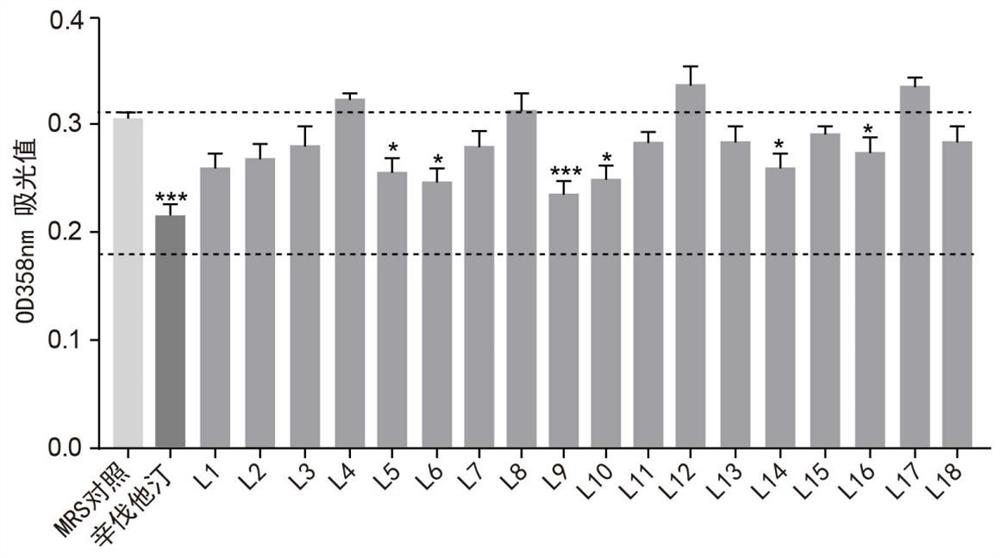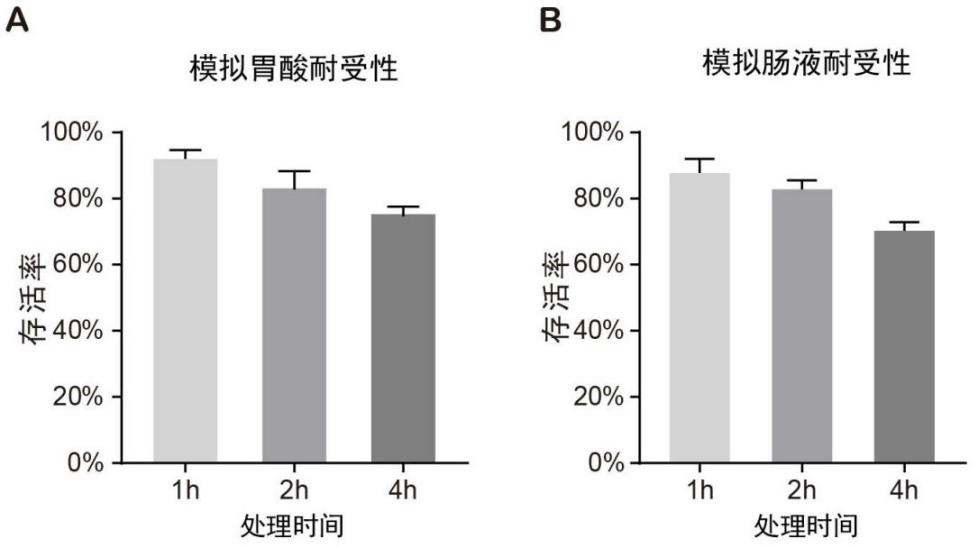Lactobacillus paracasei B111H and application thereof to metabolic syndrome
A technology for metabolic syndrome and paracheese, applied in metabolic diseases, medical preparations containing active ingredients, bacteria, etc., can solve the problems of side effects and high price, and achieve the purpose of reducing body weight and blood lipid levels, improving liver steatosis, inhibiting Effects of lipid accumulation in hepatocytes
- Summary
- Abstract
- Description
- Claims
- Application Information
AI Technical Summary
Problems solved by technology
Method used
Image
Examples
Embodiment 1
[0044] Example 1. Isolation of strains with hypolipidemic effect
[0045] The feces of several centenarians in the World Longevity Township of Chengmai, Hainan were collected as isolated samples. The collected subjects had never taken antibiotics, probiotics, or gastrointestinal diseases before collection.
[0046] Extract 5 ml of diluent from the collected stool sample, serially dilute 10-fold to 10 -6 , 200 μl of each dilution concentration was spread on selective MRS medium (peptone 10 g, beef extract 10 g, yeast extract 5 g, diammonium hydrogen citrate 2 g, glucose 20 g, Tween 80 1 mL, sodium acetate 5 g, dipotassium hydrogen phosphate 2 g, magnesium sulfate 0.58 g, manganese sulfate 0.25 g, agar 18 g, distilled water 1 000 mL), anaerobic culture at 37°C for 24-48 hours, and different single colonies on the plate were isolated. Pick different single colonies with a sterilized inoculation loop, streak and purify them on a new MRS solid medium plate, culture anaerobically a...
Embodiment 2
[0048] Embodiment 2. Preparation of live bacteria liquid, metabolites and inactivated bacteria
[0049] 2.1 Culture of strains
[0050] Take -80°C frozen bacteria liquid and spread it on the MRS solid plate, and culture it upside down at 37°C for 24-48 hours, then take a single colony and inoculate it in liquid MRS medium, and culture it at 37°C for 18-24 hours to obtain the first-generation bacterial liquid ; Take the first-generation bacterial solution and inoculate it into fresh MRS liquid medium at a concentration of 10%, and incubate at 37°C for 18-24 hours to obtain the second-generation bacterial solution; then take the second-generation bacterial solution and inoculate it into fresh MRS liquid medium at a concentration of 10% In this method, culture at 37°C for 18-24 hours to obtain the working bacterial liquid.
[0051] Obtaining live bacteria
[0052] In a specific embodiment of the present invention, the working bacterial solution obtained in step 1 is placed at 1...
Embodiment 3
[0058] Example 3. Screening and identification of bacterial strains with lipid-lowering effect
[0059] 3.1 Oil red O staining experiment
[0060] The human-derived liver cancer HepG2 cells used in the present invention are purchased from the National Biomedical Experimental Cell Resource Bank, and the culture method is a conventional culture method used in the field. In one embodiment of the invention, the culture method is: At 37°C and 5% CO 2 Cultured in high-glucose DMEM medium containing 10% fetal bovine serum (FBS) under conditions, and added double antibodies (100 μg / ml penicillin and 100 μg / ml streptomycin) in the medium at a ratio of 1:100, every 1 Replace with fresh culture medium once every 2 days, and subculture at a ratio of 1:3-4 after the cells are confluent.
[0061] The bacterial strain provided by the present invention acts on the lipid accumulation model constructed by HepG2 cells, and it is observed that the bacterial strain provided by the present invent...
PUM
 Login to View More
Login to View More Abstract
Description
Claims
Application Information
 Login to View More
Login to View More - R&D
- Intellectual Property
- Life Sciences
- Materials
- Tech Scout
- Unparalleled Data Quality
- Higher Quality Content
- 60% Fewer Hallucinations
Browse by: Latest US Patents, China's latest patents, Technical Efficacy Thesaurus, Application Domain, Technology Topic, Popular Technical Reports.
© 2025 PatSnap. All rights reserved.Legal|Privacy policy|Modern Slavery Act Transparency Statement|Sitemap|About US| Contact US: help@patsnap.com



